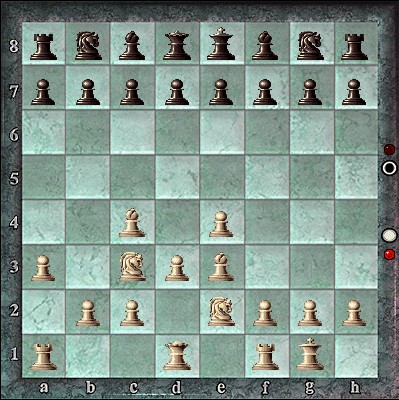|
Hello and welcome to the page that details the Stonemine position on a chessboard.
This position is fairly uncommon and difficult to achieve, but may offer substantial
rewards if it is achieved. Do not go out of your way to achieve this position. However,
sometimes the opportunity presents itself, and then you could possibly attain a similar
position to this one. |
 |
Advantages
- A balanced position, where the minor pieces are able to go to either side of the
board.
- Interlocked Knights are very stable, and are able to expand effectively to any rank.
- The "Stonemine" is so named for the curiously parallel diagonal shafts that the Bishops
are able to travel on.
|
Disadvantages
- Independent Bishops are less able to attack in tandem.
- Nc3 doesn't have much room to maneuver in this setup, and performs only a defensive
role.
- The Queen is stuck on the back row, at least until Ne2 goes somewhere
else.
|
|
Move Sequence
- e4. King's Pawn Opening.
- Bc4. Bishop's Opening.
- Nc3. Developing to protect the King Pawn.
- d3. Further support for the point man.
- Be3. Either this or the more agressive Bg5.
- a3. Defending from a future pin.
- Ne2. Interlocking both Knights for stability.
- 0-0. Castling to safety.
- Bishops on top of the Knights, but non-symmetrical. It affects the vision of play, and is
illusory and deadly for the cavalier player.
|
|
Pitfalls
Throughout the entire opening sequence, black can give white trouble with these moves:
- Na5 forces the Bishop into the corner to avoid the unwanted trade
- Bh6 tries to trade for Be3, since it can't do anything much on the a3-f8 diagonal
- d5 stays there for a long time if it doesn't first fork your minor
pieces
|
Similar Openings
1. b3 is the King's Pawn Opening.
1... d5 is the Bishop's Opening of the
King's Pawn Opening. |